Name: Chloe Circenis
Advisor: Prof. Bhuvana Narasimhan
Class: LING 4220: Language and Mind
Semester: Fall 2022
LURA 2023
Can the eccentricities of grammar in one’s native language subconsciously affect the way speakers perceive the world? The linguistic relativity hypothesis asserts that this is the case, that the language you speak influences the way you perceive reality. Previous research on this has found that an object’s name being grammatically gendered in a given language leads native speakers of that language to subconsciously perceive these objects as associated more with stereotypical male or female attributes. In my study, I investigate whether these results would also be present with native English speakers who have increasing proficiency in Spanish. More broadly, I investigate whether learning a second language can change the way we perceive the world in the same way that our native language can.
The previous results come from an experiment conducted by Webb Phillips and Lera Boroditsky (2003). In this experiment, they examined whether grammatical gender assigned to objects in Spanish and German would affect native speakers’ ideas about the genders of these objects. Phillips and Boroditsky hypothesized that the repetitive use of grammatical gender would leave semantic traces, links between grammatical gender and mental representation of objects. Their results supported this hypothesis but didn’t systematically investigate whether learning a grammatically gendered language as a second language would also affect peoples’ ideas about the gender of objects.
To examine the effect of grammatical gender on object perception in native English speakers learning Spanish as a second language, I conducted a small-scale replica of a task used in Phillips and Boroditsky’s experiment, the picture similarity task, with twelve native English speakers. Four of these were monolinguals (two female, two male) between the ages of twentyone and twenty-five. Another four were beginning-intermediate Spanish speakers (one female, two male, one undisclosed) between the ages of nineteen and twenty-three with an average selfreported Spanish proficiency of two out of five. The last four were advanced Spanish speakers (two female, two male) between the ages of twenty and fifty, with an average self-reported Spanish proficiency of four and a half out of five.
In the picture similarity task participants are given the following instructions:
In this study, you will see pairs of pictures appear on the screen. In each pair, there will be a picture of a person on the left and a picture of an object or animal on the right. Your task is to tell us how similar you think the two things being depicted are. You will see a scale where 1=not similar and 9= very similar. For each pair of pictures, please choose a number between 1 and 9 to indicate how similar you think the two things are. Please use the whole scale (give some 1's and some 9's and some of all the numbers in-between). (Phillips & Boroditsky, 2003, p. 929)
The images presented consisted of fourteen objects and eight people. Half of the fourteen objects were represented by Spanish words that are grammatically masculine in Spanish – Clock, sun, fork, toothbrush, mouse, snail, and cat – while the other half are feminine – Toaster, moon, spoon, broom, whale, frog, and fox.
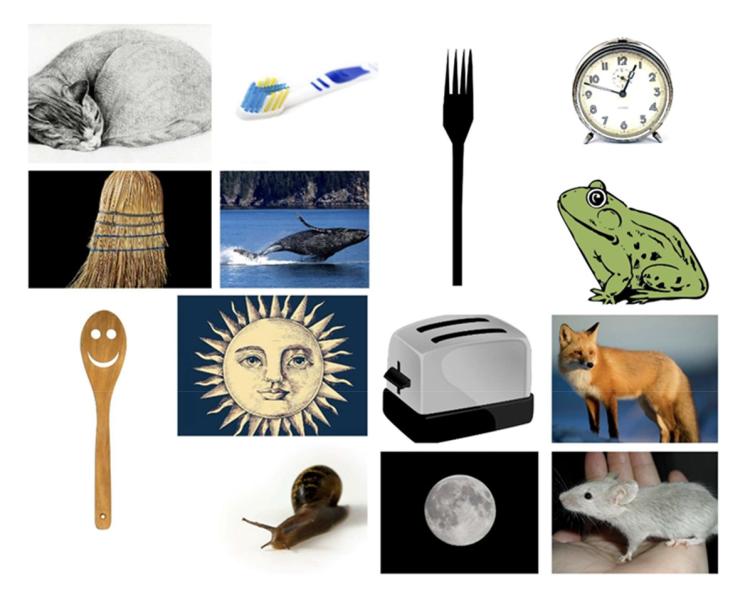
The images presented consisted of fourteen objects and eight people. Half of the fourteen objects were represented by Spanish words that are grammatically masculine in Spanish – Clock, sun, fork, toothbrush, mouse, snail, and cat – while the other half are feminine – Toaster, moon, spoon, broom, whale, frog, and fox.
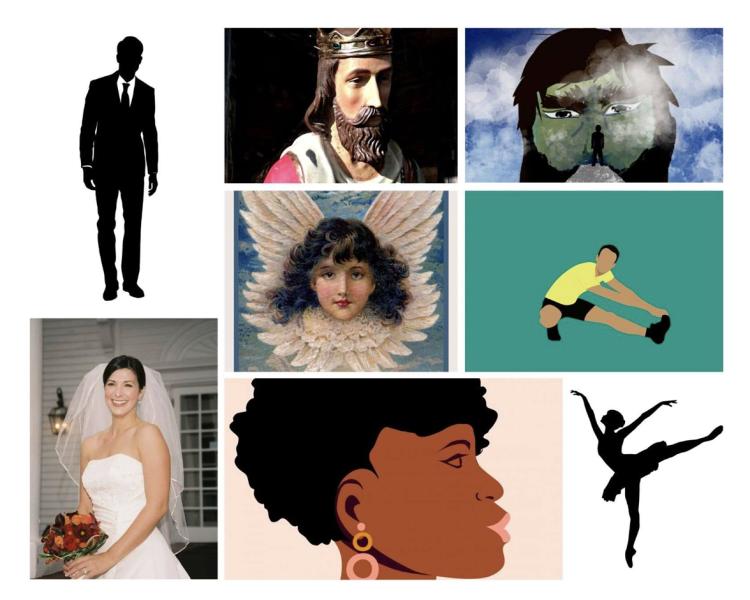
Each individual completed the task independently in English – a language without grammatically gendered nouns – on a computer, and with object-person pairs presented automatically in a randomly generated order. Responses were made by selecting a circle (labeled 1-9) on the screen. In Phillips and Boroditsky’s experiment, “Subjects found greater similarity between people and objects of matching gender than between people and objects of non-matching gender” (2003, p. 929). If second-language Spanish speakers perceive objects as gendered in relation to grammatical gender, then participants would be expected to rate object-person pairs as increasingly similar as their Spanish proficiency increases. Unfortunately, this was not the case. When analyzing the results, ratings were determined to be masculine or feminine by averaging the similarity ratings (on a scale of 1-9) of all four comparisons between each object and the four male or female person photos. Then the male or female average similarity ratings were compared for each object to see which was greater. The greater of the two average ratings marked the participant as having perceived the object as more male (a ‘male match’) than female, or vice versa (a ‘female match’). The data represented in the graphs below compares the number of times participants rated objects as more masculine or feminine.
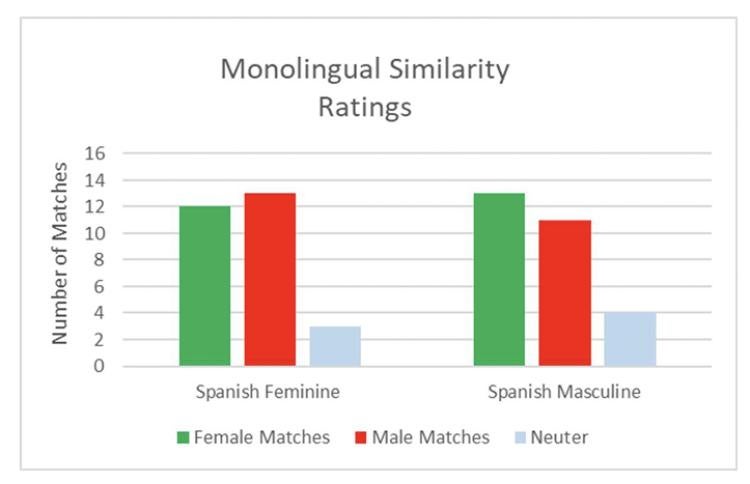
Monolinguals perceived objects that are grammatically feminine in Spanish as more masculine and objects that are grammatically masculine in Spanish as more feminine, but only by a marginal amount in both groups. Additionally, a handful (three and four) of pairs were rated as equally masculine and feminine, these will be called ’neuter’ ratings
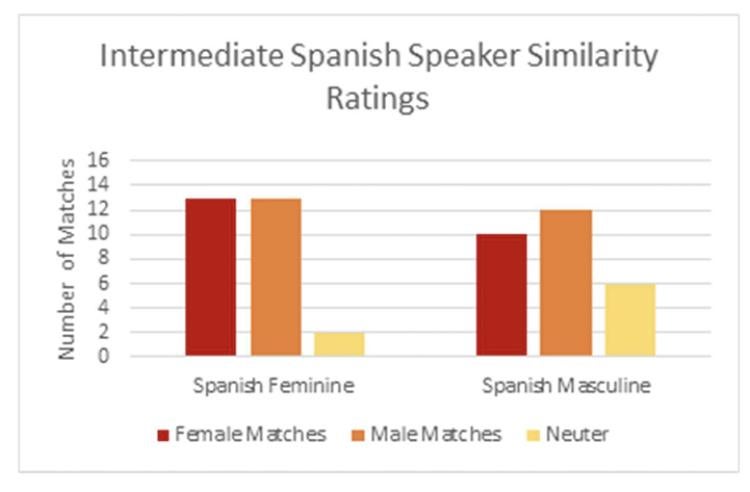
Intermediate Spanish speakers rated grammatically feminine objects as equally masculine and feminine but rated grammatically masculine objects as slightly more masculine. There was also an increase in neuter matches. These results resemble what native Spanish speakers would be expected to do more closely than the monolingual results do.
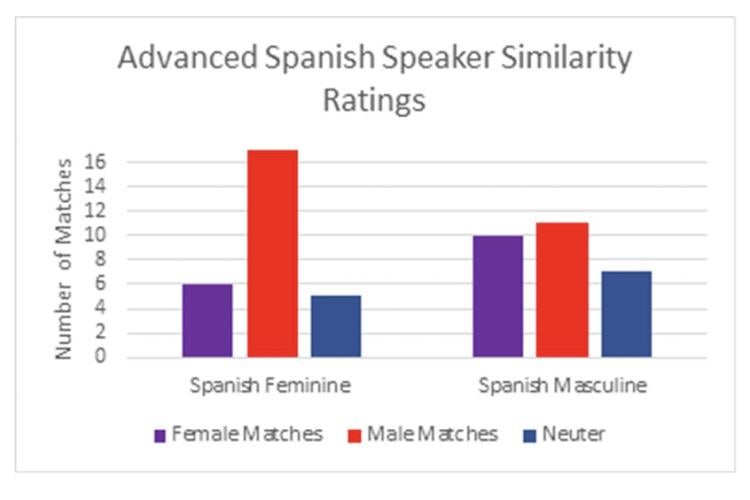
The results of the advanced Spanish speakers unfortunately do not resemble the expected behavior of native Spanish speakers more than the results of the intermediate speakers. Rather, advanced speakers rated grammatically feminine objects as drastically more masculine and grammatically masculine objects as only slightly more masculine. They had the highest number of neuter ratings.
Based on these results, the hypothesis of whether native-English second-language Spanish speakers perceive objects as more feminine or masculine in regard to the grammatical gender in Spanish is not supported as there were no substantial or consistent trends within the data retrieved. This is likely a result of having a small pool of participants who additionally may have lacked sufficient proficiency in Spanish, and thus not have forged semantic links between grammatical gender and mental representations of objects. Further study could be completed with a larger pool of more proficient participants or with the addition of a priming task to ascertain whether participants will perceive objects as stereotypically male or female when primed in Spanish.
Image Credit
Public domain pictures - free stock photos. (n.d.). Retrieved December 4, 2022, from https://www.publicdomainpictures.net/en/
References
- Circenis, C. (2022). Can learning a second language affect the way you think? Grammatical Gender and Object Concepts. Unpublished manuscript.
- Phillips, W., & Boroditsky, L. (2003). Can Quirks of Grammar Affect the Way You Think? Grammatical Gender and Object Concepts. Proceedings of the Annual Meeting of the Cognitive Science Society, 25. Retrieved from https://escholarship.org/uc/item/31t455gf

 Chloe Circenis is majoring in Linguistics while pursuing a double minor in Arabic and Hindi/Urdu, as well as a certificate in cognitive science. She is a native Coloradan and has a passion for coffee, art, and understanding the effects of language on thought and behavior.
Chloe Circenis is majoring in Linguistics while pursuing a double minor in Arabic and Hindi/Urdu, as well as a certificate in cognitive science. She is a native Coloradan and has a passion for coffee, art, and understanding the effects of language on thought and behavior.